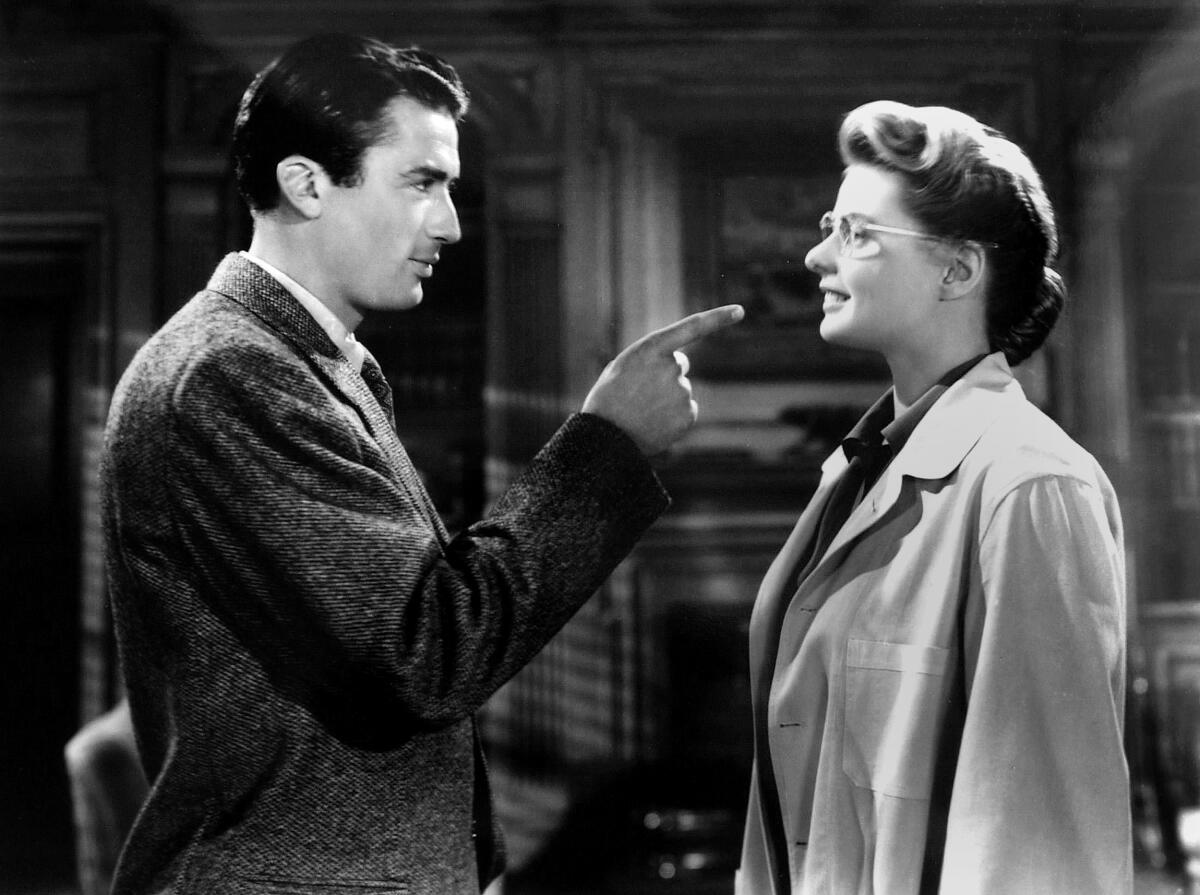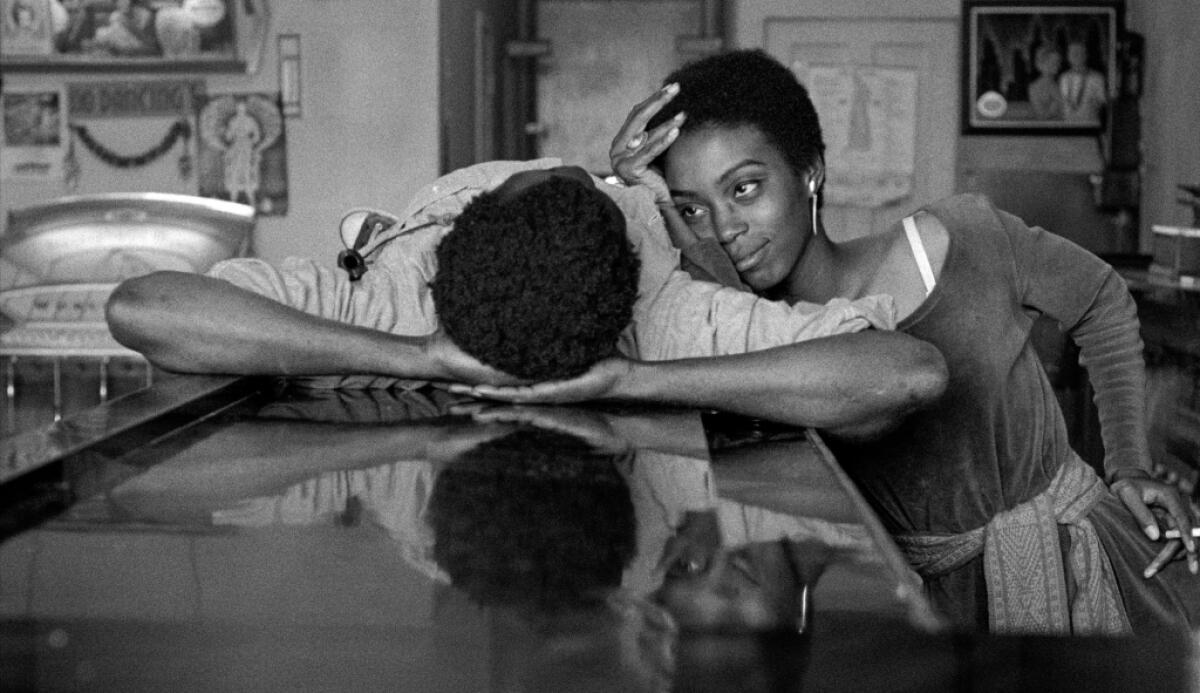See these gorgeous nitrate prints now, plus the week’s best movies in L.A.

- Share via
Hello! I’m Mark Olsen. Welcome to another edition of your regular field guide to a world of Only Good Movies.
This year’s Oscars nominees luncheon was earlier this week, with 184 of this year’s hopefuls gathered to pose for a photo together. The Times’ Josh Rottenberg was also there, where he observed the likes of Margot Robbie, Lily Gladstone, Bradley Cooper, Yorgos Lanthimos and many others working the room. Also in attendance was Messi, the dog from “Anatomy of a Fall,” who seemingly stole the show.
This week also saw a new episode of the Envelope podcast with interviews with three Oscar nominees. Shawn Finnie spoke with “Flamin’ Hot” songwriter Diane Warren; Yvonne Villarreal chatted with “Killers of the Flower Moon” cinematographer Rodrigo Prieto; and I caught up with “Anatomy of a Fall” writer-director Justine Triet.
‘It’s only going to get rarer’ at the Nitrate Film Festival

If most people know anything about nitrate film stock, it is that it is no longer used because it is extremely flammable, having been made a plot point in several movies, from Alfred Hitchcock’s “Sabotage” to Quentin Tarantino’s “Inglourious Basterds.” Yet for the handful of theaters that have the proper equipment to safely project nitrate films, they provide a remarkable viewing experience.
The recently reopened Egyptian Theatre is among the small number of venues still able to project such prints and the American Cinematheque is putting on a nitrate film festival. Running today through Feb. 24, they will be screening Alfred Hitchcock’s “Rebecca” and “Spellbound,” Vittorio De Sica’s 1948 “Bicycle Thieves” and Anthony Mann’s 1950 “Winchester ’73.”
Two of those prints come from the collection of the George Eastman Museum in Rochester, N.Y., and the Eastman’s assistant collection manager Kirk McDowell will be introducing some of the screenings. (Also appearing at screenings will be film historian Jeremy Arnold and author Kristen Lopez.) I recently spoke to McDowell about the importance of saving and watching nitrate films.
What is it about watching a nitrate print that’s special?
There are lots of festivals that focus on preservation efforts out there. And preservation is an extremely important thing. But conservation of the prints that have stood the test of time — either because of, or sometimes in spite of, their storage conditions — that’s what’s really special about a nitrate screening to me. A lot of times we’re screening original release prints of films that are 80, 90, 100 years old. You’re seeing the actual print that audiences at the time would’ve seen on the film’s original release.
We have a really special collection of all of [producer] David O. Selznick’s work here at the museum. The print of “Rebecca” that we’re sending was almost certainly viewed by David O. Selznick and Alfred Hitchcock before the film’s release. So it’s a very special print.
With “Bicycle Thieves,” that print has been in our collection since the ’50s. Our founding curator at the museum and the moving-image department, James Card, was a huge fan of Italian films and “Bicycle Thieves” in particular. So that one actually came here from the original American distributor of the film. It’s been here a long time.
Watching a nitrate print, what’s different from a contemporary 35mm print, or watching it on disc or streaming?
During the ’30s to the early ’50s, that period also lines up with really good lab work happening and also a higher density of silver content in the emulsions of film during that time. So there is a higher density of silver, which people say they can see on the screen. The other thing is that when you’re viewing a lot of these original release prints, they’re going to be straight from the negative a lot of times. So that’s going to look so much better than a print that’s two or three or four generations away.
For you, is it exciting to know that audiences in a city like Los Angeles will turn up for a movie not only due to the script or the stars, but even the material nature of the print itself?
Absolutely. It’s hugely gratifying. Working in a film archive, a lot of times it’s behind the scenes. But the point of all of film preservation and archiving is all about access. There’s no point to doing any of this if people aren’t going to see the movies and care about the movies. So it’s really special when we have screenings like this.
It’s a rare occurrence and it’s only going to get rarer as time goes by. And these prints slowly reach their ending. All of these prints will eventually be projected for the last time. We’re going through prints and seeing what the shrinkage is like. And if you look at a print and look at it five years later and the shrinkage has gotten past that point — well, it’s too bad because that will never be able to be projected. So really, I would just say to take advantage of these screenings because you’re seeing a historical artifact. You’re seeing a film the way people originally would’ve seen it.
Other points of interest
‘Hollywood 90028’

Thanks to a new 4K restoration, the 1973 film “Hollywood 90028” is being rediscovered as a disturbing exploration of dashed dreams as well as a shockingly violent example of how cheapie exploitation pictures can sometimes still be driven by more sophisticated ideas and stylish filmmaking. An aspiring photographer (Christopher Augustine) comes to Los Angeles and grows frustrated that he can only find work as a cameraman on cheap sexploitation pictures, eventually taking out his anger by strangling his female subjects. The film is also known by the titles “Hollywood Hillside Strangler” and “Twisted Throats” and writer Marc Edward Heuck called it “a spiritual bridge between Michael Powell’s ‘Peeping Tom’ and Steven Soderbergh’s “Sex, Lies, and Videotape.’” The only feature film directed by Christina Hornisher, who also wrote the screenplay under a pseudonym, “Hollywood 90028” will be playing Monday at the Los Feliz 3 as part of the ongoing Cinematic Void series celebrating cult cinema, with Augustine and actor Gayle Davis in person for a Q&A.
‘Bushman’

Mezzanine will present the L.A. premiere of a new 4K restoration of David Schickele’s 1971 “Bushman” on Feb. 21 at 2220 Arts + Archive. The film may now function best as a time capsule of late 1960s San Francisco, but it is also a bracing blend of fiction and documentary. The story follows Nigerian immigrant Gabriel (Paul Eyam Nzie Okpokam) as he finds himself caught up in the American criminal justice system, falling prey to the kind of systemic oppression he was trying to flee in the first place. When the lead actor was himself detained and deported while filming, Schickele allowed his film to take a turn toward the real as well. The Times’ Charles Champlin declared the film “a remarkably sensitive study of a man caught between cultures.”
‘Uptown Girls’ / ‘New York Minute’

On Feb 19 the New Beverly will screen a somewhat surprising double-bill of “Uptown Girls” and “New York Minute.” Starring Brittany Murphy and Dakota Fanning and directed by Boaz Yakin, 2003’s “Uptown Girls” is about a free-spirited party girl (Murphy) who has her inherited fortune swindled and is forced to take a job as a nanny for a precocious 8-year-old (Fanning). Driven largely by the unlikely chemistry between its two stars, the film is a showcase for the lively screen presence of Murphy, who died in 2009. The film is being paired with 2004’s “New York Minute,” the final film starring Mary-Kate and Ashley Olsen together before they relaunched themselves into a career in fashion. In the film, directed by Dennie Gordon, the pair play sisters, one rebellious and one straitlaced, who head from their suburban Long Island home for a big day in New York City. The movie features a very game supporting performance by Eugene Levy.
Only good movies
Get the Indie Focus newsletter, Mark Olsen's weekly guide to the world of cinema.
You may occasionally receive promotional content from the Los Angeles Times.




